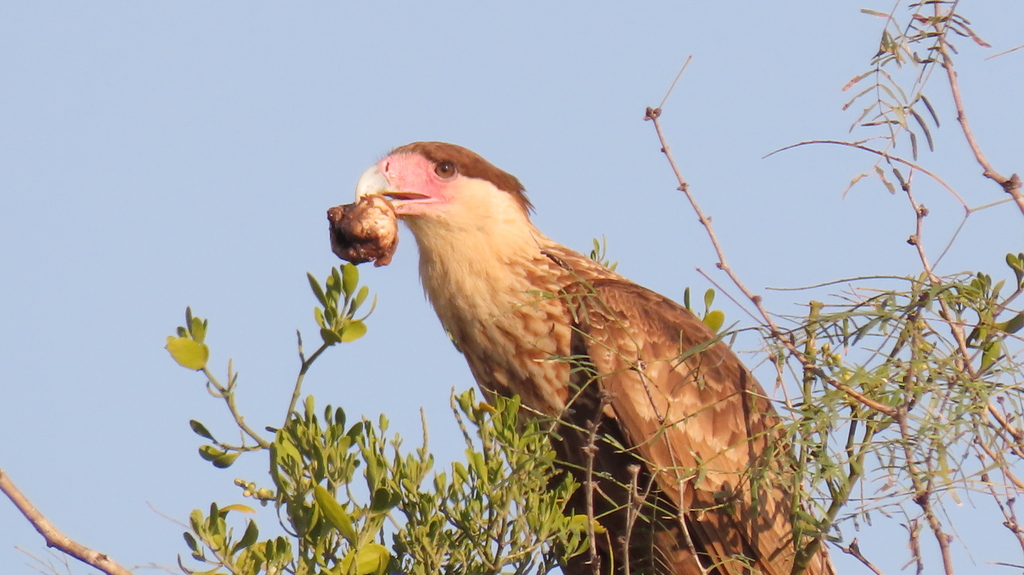
Our Observation of the Week is the first known documentation of a female Ovalimantis maculata mantis! Seen in Brazil by @ninawenoli.
Nina Wenóli, a music teacher who lives in the town of Uberlândia in Brazil, describes herself as “just a bird watcher who also records the beauties of the animal world with light.”
Her interest in birds started about seven years ago.
I decided to take a jungle behavior course and it changed my life. I started photographing birds in Brazil, but I have already visited other nearby countries as well. Today I have recorded 1,400 species of birds from Brazil alone. The time I spend in contact with nature makes me feel really good, and I intend to continue participating in photographic expeditions for a long time.
During the pandemic she started photographing insects in an empty lot by her house, and that’s when she found iNaturalist. “It was very good, because even without me knowing the genera and species, people from different parts of Brazil and the world made contact, correcting my posts and guiding me privately,” Nina says. “I started to become interested in other forms of life and recording them.”
In October, Nina traveled to Amapá, the only Brazilian state she had yet to visit, on an expedition.
The Amazon Rainforest presents many difficulties for photographing birds, and between one bird photo and the next I kept photographing butterflies, flowers, fungi, various insects, rocks, lichens and trees, because the biodiversity in the region is very rich. I live in the Cerrado, which is a very different biome, so I took advantage of my situation and photographed everything I saw when time allowed. One afternoon this mantis appeared [on my friend’s back] and I managed to photograph it with my cell phone…I realized it was very handsome and very strange. I took a few photos, so as not to disturb the animal, and then placed it on a nearby branch.

Nina (above) posted her photos on December 2nd and it caused quite a stir among the mantis experts on iNaturalist. She writes,
A few hours later, I received messages from several entomologists and iNaturalist followers, delighted with the post. I say sincerely, I am very happy and grateful for this opportunity to contribute to science.
I contacted a few of the entomologists who commented on Nina’s observation and heard back from Julio (@piskomantis) and Antonio (@mondodellemantidi). They tell me that this species was described in 2015, and only from a male specimen found in French Guiana. A female had never been documented until Nina’s iNaturalist observation and, says Antonio,
The observation of a female Ovalimantis published on iNaturalist immediately aroused the interest of mantis enthusiasts who frequent the platform. We were literally amazed, also by the particular shape of the body of this mantis, not comparable to that of any other…Globally, this observation will help us better understand the biodiversity of South American insects, and will be very useful as the only photographic documentation of a female of Ovalimantis, similar to what happened a few months ago with the uploading on this platform of the observation of an adult female of Amphecostephanus sp., an African mantis of which only male specimens were known and photographed (and, ironically, this mantis is also extremely mimetic and similar to a dry leaf with a showy process on the head!!)
Julio chimes in on the importance of finding a female:
The discovery is remarkable because many praying mantis species are known only from males, which can differ significantly from females. The sexual dimorphism, or differences between males and females, is pronounced in praying mantises, and both sexes are essential for a comprehensive understanding of their taxonomy.
Ovalimantis maculata is currently in the family Acanthopidae, and Julio says
Praying mantises are challenging to classify based on morphology, especially when a species possesses unique characteristics not shared with others. This is precisely the case with Ovalimantis maculata, known for its extremely short thorax with a unique conformation among all tropical American mantises. It also has a disproportionately large head, with distinctive projections and horns not observed in any other species. Due to the uniqueness of its morphology, genetic studies are necessary to classify Ovalimantis maculata more accurately. We are likely dealing with a completely new lineage of acanthopoids.
Not only is it the first known documented female of the species, its location also extends the range into Brazil - not bad for a mantis found on a friend’s back!
Julio and Antonio also stressed how important iNat is to their work.
Antonio:
I am a mantis enthusiast who studies and does independent research on these insects, also collaborating with other scholars. I use the platform mainly to identify mantis specimens of all over the world and monitor the distribution of those that I study in more detail, including the alien species of the Hierodula genus that have invaded Europe for some years.
Julio (who also runs the Os Louva-a-Deus do Rio de Janeiro project):
In recent years, especially since the pandemic, I have extensively used iNaturalist, and it has become a fundamental tool in my work studying the diversity of praying mantises in tropical America. Praying mantises are challenging to observe, collect, and have low population densities…
On iNaturalist, I have observed numerous new records, undescribed species, and even new genera awaiting formal scientific discovery. I also use iNaturalist to obtain images of specimens for my research, which aims to incorporate artificial intelligence tools into the study of praying mantis biodiversity by professional and citizen scientists. This work is conducted in partnership with the Montreal Insectarium and the Université de Montreal, Quebec, Canada. In summary, iNaturalist is an immensely helpful tool for my studies of these wonderful and elusive insects, and I continually seek new ways to incorporate it into my research.
(Photo of Nina by Elizete Nogueira Barbosa. Thank you to @luis2 and @patriciatiago for some translation help. Some quotes have been modified for clarity.)
- acanthopid mantids are truly remarkable, check out the most faved observations of them!
- a newly described Australian mantis was named in honor of iNat!











































